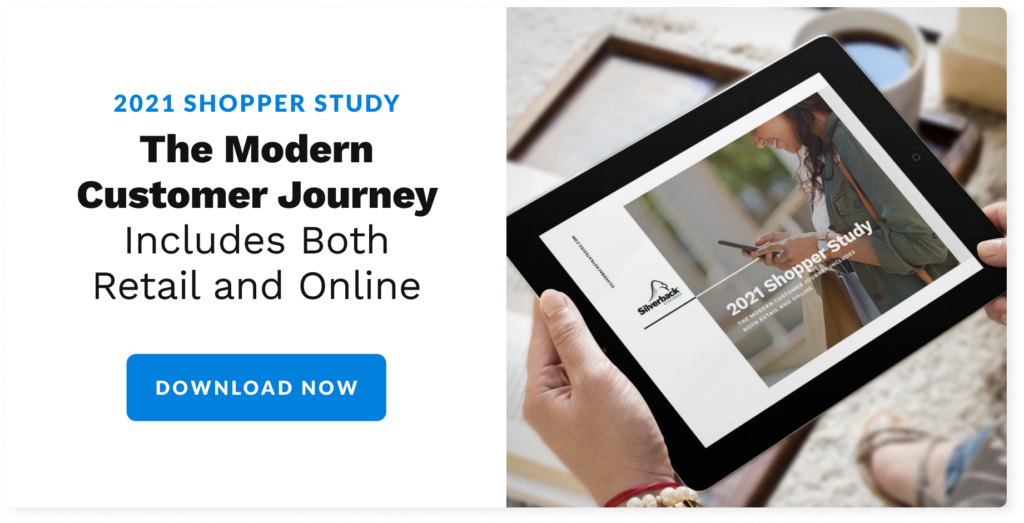
The 2020 holiday season was unlike any other we experienced in the United States. Some might even call it “unprecedented,” but we won’t go there.
With COVID-19 restrictions, recommendations and realities mixing together to create no cohesive set of information on which to make decisions, we created a survey about shopping and analyzed consumer behavior during the season.
While we published the entirety of our survey findings in our 2021 Shopper Study: The Modern Customer Journey Includes Both Retail and Online, in this blog we’ll dive deep into specific data to paint a more complex picture of the buyer behavior we examined.

Shopping Method by Region
COVID-19 mandates and restrictions varied greatly by not only region, but by state. However, if we group states into regions, we see a broader picture of behavior.
What is undisputed is the overwhelming majority of people choosing to shop in store regardless of region.
Regions including New York and Chicago had more in-store shoppers than regions with less strictly regulated states like Florida.
Similarly intriguing, more shoppers in the Southeast (like Florida and Georgia) chose to only shop online to avoid gathering in public than elsewhere.
Overall, the decision to avoid brick-and-mortar stores was a rare one, with in-store shopping clearly being the preferred method of gift-buying in 2020 regardless of region. Retail brands shouldn’t be deterred from driving traffic to stores based on regional COVID-19 guidance, but should consider each region’s comfort level as restrictions ease. Many types of consumers may continue to prefer avoiding stores, so ensure online shopping stays seamless and convenient.
Shopping Method by Social Media Usage
Our survey also looked at the kinds of social media platforms respondents used in an effort to help marketers understand where they could reach their customers. While we know more shoppers went to stores than went online, it’s clear a large majority of shoppers are using social media.
If you’re looking to entice people into the store, social media is still a strong way to reach shoppers with in-store discounts, events and more. Even if they’re shopping in stores, they’re still active online.
With the close margin between in-store and online-only shoppers in using virtually all platforms, use social media to meet the customers where they are. Take stock of your sales trends and lead them to whichever method of shopping you desire.
Marketers likely want to research the positives and negatives of each platform and choose which one both fits their brand values and reaches the right audiences. It’s also a good idea to consider offline ways of marketing for the chunk of customers unswayed by influencer marketing and rely on more traditional advertising, perhaps via print or direct mail.
Shopping Method by Generation
Using the idea of younger TikTokers rushing to stores without abandon as a springboard, we wondered if shopping choices varied by generations at large. Considering a few generations were more at risk of COVID-19 complications than others, would their shopping behavior be more cautious?
Surprisingly, or maybe not by this far into the blog, Boomers still shopped predominantly outside their homes, even as the least likely to do so.
Baby Boomers were two times more likely to shop in-store than keep their shopping online. While the virus was typically much deadlier for this age group, a majority went about their holiday shopping without much deviation from years past.
Even though today many households are a mixed bag of generations, there is no one group deciding to stay more insulated from germs and close-contact at retail stores than others. In fact, the often-criticized Millennial and Gen Z groups were less likely to report yes, they did visit a store (78.5% and 71.6%, respectively) than Gen X, where nearly 80% of respondents shopped at brick-and-mortar locations.
These findings are big for retailers. While we can generally confirm from our survey Boomers were more likely to do their holiday shopping exclusively online, the majority didn’t. If this is the most cautious group of shoppers, it stresses the value of encouraging store visits in addition to keeping options for low- to no-contact shopping available.
Even if your products or services are tailored for one age group over another, there is no clear reason to avoid in-store marketing or driving foot traffic. There is no overwhelming aversion from any generation to avoid their favorite stores.
Conclusion
All this to say…there is no reason to dramatically change your retail marketing playbook to cater to any one consumer shopping trend. Our holiday buying behavior data shows people still enjoy browsing products, touching fabrics or even just seeing the product in front of them before committing to buy.
On the flip side, there are some who appreciated the flexibility and safety afforded by online-only shopping, and preferred to stay home during high-traffic seasons.
With widespread vaccination and further clarity into the ongoing impact of COVID-19, retail marketers need to stay agile. For now, a mix of in-store and online marketing efforts will pay off more than putting every egg in either basket, with many shoppers visiting a store and then purchasing it online after!
The modern retail buyer journey is truly a hybrid, and retail marketers will need to find effective ways to entice shoppers on each step of the way, both online and not.
If you want more insight into what kinds of items shoppers purchased during the 2020 holidays, how much they were spending and more, you’ll really want to download our full report.
When you’re ready to optimize your online presence to capitalize on the new retail customer journey, we’ll be here to support you. Just let us know when we can join you on the path.
Recent Posts
Creative Strategy in Digital Advertising
Read the ArticleEthical Considerations of AI In Marketing: Balancing Innovation with Responsibility
Read the ArticleTop-Down vs. Bottom-Up Budgeting: Which Should You Use?
Read the Article
Unlock Your Growth Potential
Silverback helps businesses catapult web traffic, leads, and sales. We combine analytical and creative expertise to drive inbound marketing campaigns and track it all to find insights on what worked, what didn’t, and what we should try out next.
Contact Us